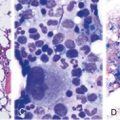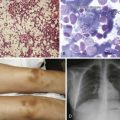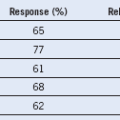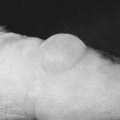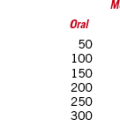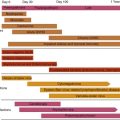Chapter 64 Stroke
Table 64-1 Traditional Risk Factors for Ischemic Stroke
| Risk Factor | OR (99% CI) |
|---|---|
| Hypertension (self-reported history) | 2.37 (2.00-2.79) |
| Current smoking* | 2.32 (1.91-2.81) |
| Diabetes mellitus | 1.60 (1.29-1.99) |
| Ratio of apoB to apoA1 | 2.40 (1.86-3.11) |
| Obesity (waist-to-hip ratio) | 1.69 (1.38-2.07) |
| Regular physical activity | 0.68 (0.51-0.91) |
| Diet risk score | 1.34 (1.09-1.65) |
| Alcohol consumption* | |
| 1-30 Drinks per month | 0.79 (0.63-1.00) |
| >30 Drinks per month | 1.41 (1.09-1.82) |
| Psychosocial factors | |
| Psychosocial stress | 1.30 (1.04-1.62) |
| Depression | 1.47 (1.19-1.83) |
apo, Apolipoprotein; CI, confidence interval; OR, odds ratio.
*Comparator for current smoker and alcohol intake is never or former.
From O’Donnell MJ, Xavier D, Lisheng L, et al: Risk factors for ischaemic and intracerebral haemorrhagic stroke in 22 countries (the INTERSTROKE study): A case-control study, Lancet 376:112, 2010.
Table 64-2 Eligibility Criteria and Contraindications for Acute Thrombolysis in Acute Ischemic Stroke
| ELIGIBILITY CRITERIA |
| Diagnosis of ischemic stroke causing measurable neurologic deficit Neurologic signs not minor or isolated (caution to be exercised in treating patients with major deficits) Onset of symptoms <3 hours before beginning treatment (some guidelines suggest up to 4.5 hours) Neurologic signs not clearing spontaneously Symptoms of stroke not suggestive of subarachnoid hemorrhage Patient and/or family members aware of potential risks and benefits of treatment |
| CONTRAINDICATIONS FOR THROMBOLYSIS |
| Evidence of intracranial hemorrhage on CT Head trauma or prior stroke in previous 3 months Myocardial infarction in previous 3 months Gastrointestinal or urinary tract hemorrhage in previous 21 days Arterial puncture at a noncompressible site in previous 7 days Major surgery in previous 14 days History of previous intracranial hemorrhage Blood pressure elevated (systolic >185 mm Hg and diastolic >110 mm Hg) Evidence of active bleeding or acute trauma (fracture) on examination Taking an oral anticoagulant or, if anticoagulant being taken, INR ≥ 1.7 If received heparin in previous 48 hours, aPTT outside the normal range. Platelet count ≤ 100,000,mm3 Blood glucose concentration ≤ 50 mg/dL (2.7 mmol/L) Seizure with postictal residual neurologic impairments CT showing a multilobar infarction (hypodensity >1/3 cerebral hemisphere) |

